| Listing 1 - 10 of 18 | << page >> |
Sort by
|
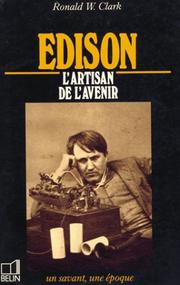
ISBN: 2701106206 9782701106205 Year: 1986 Publisher: Paris : Belin,
Abstract | Keywords | Export | Availability | Bookmark
 Loading...
Loading...Choose an application
- Reference Manager
- EndNote
- RefWorks (Direct export to RefWorks)
Book
Year: 1973 Publisher: Washington, D.C. : Office of Publications, National Park Service, U.S. Dept. of the Interior,
Abstract | Keywords | Export | Availability | Bookmark
 Loading...
Loading...Choose an application
- Reference Manager
- EndNote
- RefWorks (Direct export to RefWorks)
Inventors --- History. --- Edison, Thomas A.
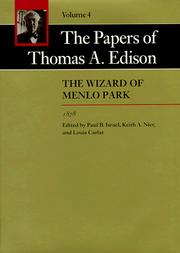
ISBN: 1421442256 1421412896 0801858194 Year: 1998 Publisher: Johns Hopkins University Press
Abstract | Keywords | Export | Availability | Bookmark
 Loading...
Loading...Choose an application
- Reference Manager
- EndNote
- RefWorks (Direct export to RefWorks)
This newest volume in the acclaimed Papers of Thomas A. Edison covers one year in the life of America's greatest inventor—1878. That year Edison, whom a New York newspaper in the spring first called "the Wizard of Menlo Park," developed the phonograph, one of his most famous inventions; made a breakthrough in the development of telephone transmitters, which made the instrument commercially viable; and announced the advent of domestic electric lighting, with only a few weeks' worth of tinkering necessary to complete its design (the announcement sent gas-company stocks plummeting; the research and development went on for four years).These inventions brought Edison financial support for his work and attention from the public. In January investors in the Edison Speaking Phonograph Company agreed to fund development work on the phonograph. The invention made Edison internationally famous and in May he traveled to Washington, D.C., to show the phonograph at the National Academy of Sciences, to Congress, and to President Rutherford B. Hayes at the White House. That same month Western Union agreed to pay Edison an annual salary of $6,000 for his telephone inventions, although other support from the company declined following the death of its president, William Orton. The stress of unceasing public attention, including a trans-Atlantic dispute over the question of who invented the microphone, led an exhausted Edison to travel west during the summer to witness a solar eclipse but also to seek rest. His six-week trip took him to San Francisco and the Yosemite region of California. Edison began working on electric lighting after his return and in October the Edison Electric Light Company was formed to support his research.
Book

ISBN: 1421442248 1421412888 0801831024 Year: 1994 Publisher: Johns Hopkins University Press
Abstract | Keywords | Export | Availability | Bookmark
 Loading...
Loading...Choose an application
- Reference Manager
- EndNote
- RefWorks (Direct export to RefWorks)
The third volume of this widely acclaimed series reveals the breath-taking intensity, intellectual acumen, and vast self-confidence of twenty-nine-year-old Thomas Edison. In the depths of the 1870s depression, he moved his independent research and development laboratory from industrial Newark to pastoral Menlo Park, some fifteen miles to the south on the main line of the railroad from New York to Philadelphia. There, equipped with resources for experimental development that were extraordinary for their time, Edison and a few close associates began twenty months of research that expanded their well-established accomplishments in telegraphy into pioneering work on the telephone. Edison's ideas and techniques from telegraph message recording and the telephone next led to his invention of the phonograph, the first patent for which was filed in December 1877. This invention ultimately gave Edison a world-wide reputation—and the nickname "the wizard of Menlo Park."
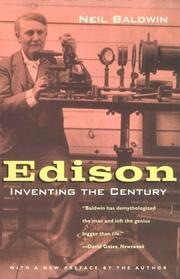
ISBN: 0226035719 Year: 2001 Publisher: Chicago London : University of Chicago Press,
Abstract | Keywords | Export | Availability | Bookmark
 Loading...
Loading...Choose an application
- Reference Manager
- EndNote
- RefWorks (Direct export to RefWorks)
Book

Year: 2021 Publisher: Johns Hopkins University Press
Abstract | Keywords | Export | Availability | Bookmark
 Loading...
Loading...Choose an application
- Reference Manager
- EndNote
- RefWorks (Direct export to RefWorks)
This richly illustrated volume explores Edison's inventive and personal pursuits from 1888 to 1889, documenting his responses to technological, organizational, and economic challenges.Thomas A. Edison was received at the 1889 Paris Exposition Universelle—the World's Fair—as a conquering hero. Extravagantly fêted and besieged by well-wishers, he was seen, like Gustave Eiffel's iron tower, as a triumphal symbol of republicanism and material progress. The visit was a high-water mark of his international fame.Out of the limelight, Edison worked as hard as ever. On top of his work as an inventor, entrepreneur, and manufacturer, he created a new role as a director of research. At his peerless laboratory in Orange, New Jersey, he directed assistants working in parallel on multiple projects. These included the "perfected" phonograph; a major but little-recognized effort to make musical recordings for sale; the start of work on motion pictures; and improvements in the recovery of low-grade iron ore. He also pursued a public "War of the Currents" against electrical rival George Westinghouse. Keenly attuned to manufacturing as a way to support the laboratory financially and control his most iconic products, Edison created a new cluster of factories. He kept his manufacturing rights to the phonograph while selling the underlying patents to an outside investor in a deal he would regret. When market pressures led to the consolidation of Edison lighting interests, he sold his factories to the new Edison General Electric Company. These changes disrupted his longtime personal and professional relations even as he planned an iron-mining project that would take him to the New Jersey wilderness for long periods.The ninth volume of the series, Competing Interests explores Edison's inventive and personal pursuits from 1888 to 1889, documenting his responses to technological, organizational, and economic challenges. The book includes 331 documents and hundreds of Edison's drawings, which are all revealing and representative of his life and work in these years. Essays and notes based on meticulous research in a wide range of sources, many only recently available, provide a rich context for the documents.
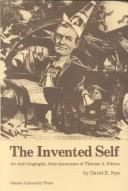
ISBN: 8774924621 9788774924623 Year: 1983 Volume: 7 Publisher: Odense : Odense university press = Odense Universitetsforlag,
Abstract | Keywords | Export | Availability | Bookmark
 Loading...
Loading...Choose an application
- Reference Manager
- EndNote
- RefWorks (Direct export to RefWorks)
Inventors --- Biography --- Edison, Thomas A --- -Inventions --- Engineers --- Edison, Thomas A. --- Edison, Thomas Alva, --- -Biography --- Biography. --- Edison, Thomas A., --- Ai-ti-sheng, --- Ėdison, Tomas Alʹva, --- Ėdisson, Tomas-Alʹva, --- トーマス· A ·エジソン, --- Edison (Thomas Alva) --- Edison (Thomas Alva). --- Inventors - United States - Biography --- Edison, Thomas Alva, - 1847-1931
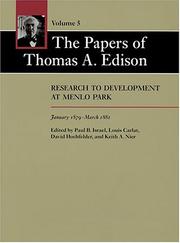
ISBN: 1421442264 1421412853 0801831040 Year: 2004 Publisher: Johns Hopkins University Press
Abstract | Keywords | Export | Availability | Bookmark
 Loading...
Loading...Choose an application
- Reference Manager
- EndNote
- RefWorks (Direct export to RefWorks)
The fifth volume of The Papers of Thomas A. Edison covers Edison's invention and development of the first commercial incandescent electric light and power system. In the process he turned his famed Menlo Park laboratory into the first true research and development facility. This also enabled him to develop a new telephone for the British market in the midst of his herculean efforts on electric lighting.In the face of daunting technical challenges and skepticism from leading scientists and engineers, Edison and his team of experimenters and machinists found the solution to the decades-old problem of creating a practical incandescent lamp. By focusing on the characteristics of the entire system Edison reconceptualized the requirements of a successful lamp design. While rivals worked primarily on lamps, Edison developed other parts of a complete system as well. This approach was most notable in his revolutionary work on generator technology, one of the highlights of this volume. Successful exhibitions of the system in December 1879 drew crowds to Menlo Park to witness the softly glowing lamps. These spectacles gratified his financial backers but Edison realized the importance of following experimental demonstrations with the hard work of commercial development. He needed to make each component work effectively in daily use and to improve the designs so that they were easy to use and inexpensive to manufacture. To create a daytime market for electricity he also developed electric motors for a variety of uses, including electric railways, for which he built a small demonstration line at Menlo Park. To accomplish all this Edison greatly enlarged his staff to as many as sixty experimenters, machinists, carpenters, and office workers. He began manufacturing lamps at a factory in Menlo Park. At the end of 1880, Edison was ready to move his system into commercial production and made plans to produce other components in New York. He also invited New York officials to a demonstration in order to win their approval for running underground lines in lower Manhattan where he planned to put his first commercial central station. In March 1881, he moved to the Edison Electric Light Company's headquarters on Fifth Avenue and began the hard work of introducing the new electric light and power technology.
Book

ISBN: 142144223X 1421412918 0801831016 Year: 1991 Publisher: Johns Hopkins University Press
Abstract | Keywords | Export | Availability | Bookmark
 Loading...
Loading...Choose an application
- Reference Manager
- EndNote
- RefWorks (Direct export to RefWorks)
The second volume of The Papers of Thomas A. Edison, which covers the inventor's life from the end of June 1873 to the end of March 1876, reveals a remarkable diversity of activities and interests. During his late twenties Thomas Edison pursued his pathbreaking work in telegraph technology, formed a business alliance with the notorious financier Jay Gould, and became embroiled in a bitter legal battle over commercial rights to his quadruplex telegraph. Praise for previous volumes of The Papers of Thomas A. Edison:"The essence of the volume is Edison's technical notebooks, a window onto the inventor's workshop. His lucidity comes through everywhere . . . His writing and drawing come together as a single, vigorous thought process."—Russell McCormmach, New York Times."A mine of material . . . Scrupulously edited . . . No one could ask for more . . . A choplicking feast for Edison biographers—well into the next century, and perhaps beyond."—Fred Howard, Washington Post."A triumph of the bookmaker's art, with splendidly arranged illustrations, essential background information, and cautionary reminders of the common sources on which Edison's imagination drew."—David Joravsky, New York Review of Books."In the pages of this volume Edison the man, his work, and his times come alive . . . A delight to browse through or to read carefully."—Thomas J. Misa, Science.
Inventors --- Edison, Thomas A. --- History of engineering & technology
Book
Year: 1929 Publisher: Paris : Payot,
Abstract | Keywords | Export | Availability | Bookmark
 Loading...
Loading...Choose an application
- Reference Manager
- EndNote
- RefWorks (Direct export to RefWorks)
Edison (thomas alva), 1847-1931 --- Inventeurs --- Etats-unis d'amerique
| Listing 1 - 10 of 18 | << page >> |
Sort by
|

 Search
Search Feedback
Feedback About
About Help
Help News
News